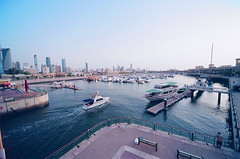I finally got around to developing the film that I shot with the Nikon F100. The place where I got it developed also gave me a CD of all the developed pictures, which is pretty cool. It's almost like shooting digital.
The thing that I love about the F100 is that my lenses give true focal length as opposed to the D200, which has a small sensor resulting in a 1.5x crop factor. In other words, when I mount a 50mm lens on the F100, it appears as 50mm, while on the D200, the same lens appears as 75mm (50x1.5 crop factor).
This makes ultra-wide angle shooting a bit of a problem on the D200. Take for example the Sigma 12-24mm lens that I own. On the D200, it appears as 18-36mm. That's pretty wide...but when I mount the same lens on the F100, it is actually 12-24mm!!. That super wide.
The crop factor problem has now been solved by Nikon with the newer "FX" format cameras (D3 and D700 are the only 2 cameras from Nikon that currently have a FX sensor). I will eventually upgrade to these camera bodies but not just yet - as the D200 that I own is good enough for the time being.
This picture of the Sharq marina was taken with the Sigma at it's widest focal length of 12mm. It is so wide, that the entire marina can be captured on film. Of course, there is serious perspective distortion but that expected when shooting at such wide focal range.
I was not happy with the colors but I believe that has more to do with the film selection than with the camera itself. I am looking to see if I can get hold of some pro-grade film to do more experiments with film.

4 comments:
wow thats wide ! what kind of pro grade films are there ? this may be a stupid question but here goes.. whats the advantage of having a full frame camera like a Nikon D3 ?
There are 2 key advantages for using a camera with a FX sensor.
1. The lens works as it was designed. e.g. a 20mm lens gives you exactly a 20mm field of view. This allows you to go really wide. There is a downside ofcourse. While a 200mm lens effectively becomes 300mm on a DX sensor (giving you more telephoto range), it will be 200mm on a FX sensor.
2. The size of a FX sensor is very big (almost twice as much area as the DX sensor). This means that the density of the pixels will be less resulting in better ISO performance. For e.g. A D3 can shoot at ISO 6400 without significant noise in the image.
that's a beautiful picture Cajie! What time of day did you take this at?! I never get pics like this :(
I took this picture just before sunset.
Post a Comment